Gone are the days when the idea of an office is a Tetris-like jumble of cubicles with zero employee interaction allowed. Numerous studies have proven that high employee satisfaction directly correlates to a highly-productive workplace. This is the reason why companies today are more open to the idea of wellness rooms in the workplace.
But how do we design a corporate wellness room? There are many factors to weigh when creating a wellness room. You will need to consider the wellness room’s primary use, the type of lighting, flooring, and wall finish, as well as the amenities to be provided.
A productive office means setting aside space inside the workplace with employee well-being in mind. This article touches on design principles with employee welfare and productivity in mind. We will dive deeper into how to design a wellness room in your workplace, what a corporate wellness room is, and its importance to workplace dynamics.
What Should a Corporate Wellness Room Look Like?
Before, company-provided breakrooms are spaces which double as the office pantry as well as the dining area. Breaks are often associated with mealtimes and rarely anything else. However, nowadays, the standard for employee wellness has now expanded to include various aspects of physical and mental wellness. Therefore, a room filled with coffee and snacks, a microwave, and a refrigerator doesn’t cut it anymore.
So what does a modern corporate wellness room look like? Smart design now plays a significant role in cultivating a healthy and productive work environment . Companies have adapted ideas like open-floor concepts, green spaces, and co-working spaces when designing office space. Keeping employees at the peak of their game is the most significant objective that corporate wellness rooms address. There are many design principles and ideas to consider to achieve this.
. Companies have adapted ideas like open-floor concepts, green spaces, and co-working spaces when designing office space. Keeping employees at the peak of their game is the most significant objective that corporate wellness rooms address. There are many design principles and ideas to consider to achieve this.
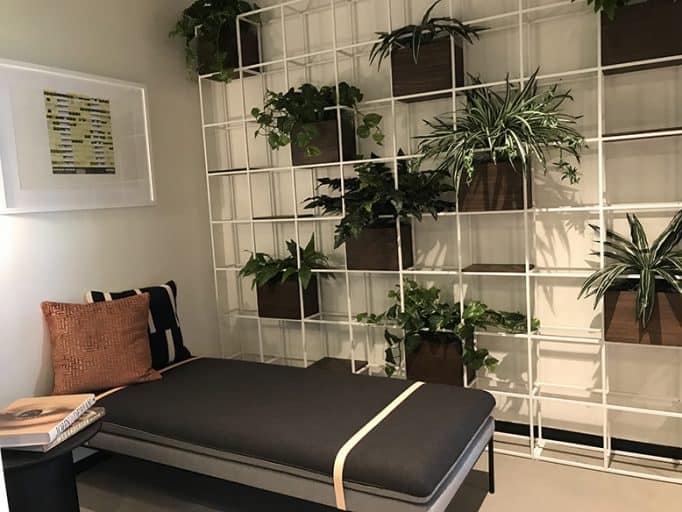
First, determining the type of wellness room suitable for your office is necessary before taking any step. There are different types and themes to choose from, but it’s not required to have everything available in your office. Some companies could afford to splurge on state-of-the-art fitness gyms; others content themselves with well-lit co-working spaces and a comfortable breakroom. Regardless of budget or resource availability, options are available, which includes a wide range of affordability and function.
suitable for your office is necessary before taking any step. There are different types and themes to choose from, but it’s not required to have everything available in your office. Some companies could afford to splurge on state-of-the-art fitness gyms; others content themselves with well-lit co-working spaces and a comfortable breakroom. Regardless of budget or resource availability, options are available, which includes a wide range of affordability and function.
After determining the type of wellness room that best fits your office, another thing to consider and plan for is the interiors. A room with four walls corralled from the rest of the main working space is not enough to be called a “wellness room.” Practical and smart design makes use of fundamental design principles such as lighting, color, material, and texture to evoke the feeling of comfort and relaxation. Using appropriate design principles will boost a small wellness room into something beneficial to overworked workers.
such as lighting, color, material, and texture to evoke the feeling of comfort and relaxation. Using appropriate design principles will boost a small wellness room into something beneficial to overworked workers.
Finally, available amenities are also essential when constructing a corporate wellness room. Employees are more likely to enjoy at work when their basic needs are met, and specific facilities are there for them to enjoy.
Types of Wellness Rooms
Designing office spaces has evolved over the years, and this manifested in many ways. In the same way, wellness rooms come in all sorts of themes and sizes. There is no single definition or standard followed when it comes to what a corporate wellness room is and how it should look. The general idea is to provide a space for relaxation for workers before they return to work. The place or area must be secure and private, away from prying eyes as well as the daily stress of office work.
Here are four of the most common wellness rooms:
1. Exercise Room
One of the health problems that are indirectly caused by work is the lack of physical activity . Staying inside an airconditioned room seated for hours while typing on a computer is not ideal for the human body. People need exercise or some physical activity to avoid problems like obesity and hypertension.
. Staying inside an airconditioned room seated for hours while typing on a computer is not ideal for the human body. People need exercise or some physical activity to avoid problems like obesity and hypertension.
Installing a fitness gym at the office is one sure way to provide an avenue for your workers to get that 30-minute minimum of exercise. Some companies invest in professional gym equipment such as treadmills, stationary bikes, and weights. Keep in mind, however, that this is not a requirement for your corporate wellness room.
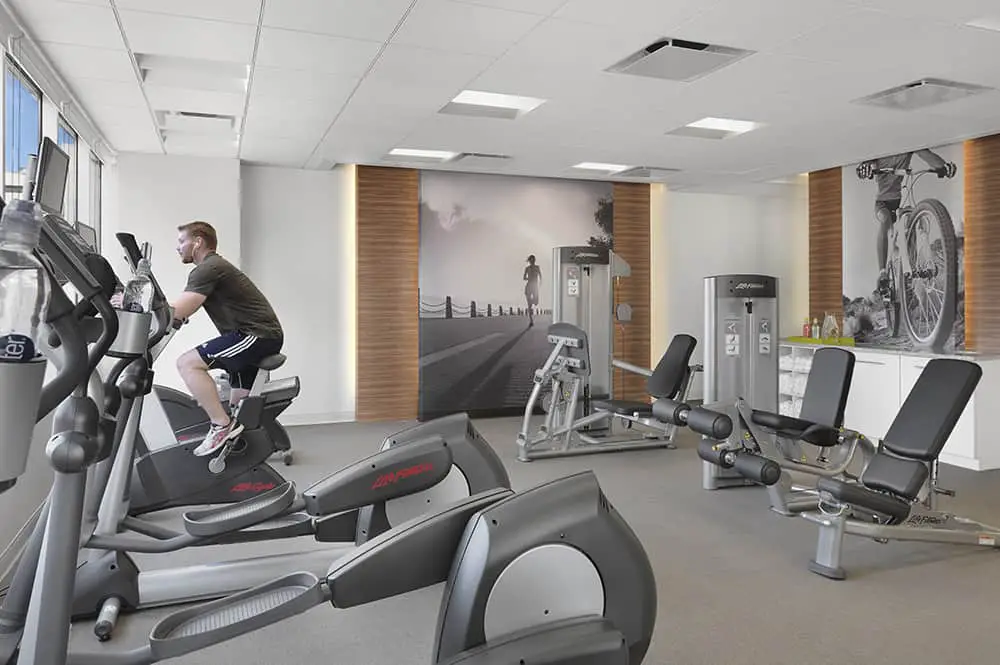
2. Rest and Relaxation Room
The physical and mental demands of the workplace can sometimes be too much for an employee to handle. Sleepless nights spent finishing project presentations or even the early commute sometimes force employees to be at work despite the lack of sleep or proper rest. A wellness room dedicated to rest is a perfect solution for overworked employees.
of the workplace can sometimes be too much for an employee to handle. Sleepless nights spent finishing project presentations or even the early commute sometimes force employees to be at work despite the lack of sleep or proper rest. A wellness room dedicated to rest is a perfect solution for overworked employees.
This type of wellness room doesn’t need much in terms of equipment. A comfortable couch, or if you’re gearing for a more playful vibe, some colorful beanbag chairs should do the trick. Adding some cushions and blankets is also a nice touch. A room for relaxation like this could help employees in need of a boost of energy. A short nap in the wellness room is just the perfect answer.
Previously, break rooms are well-loved spaces in the office because of the promise of caffeine. This is particularly true for employees who work long or odd hours, especially those who have a graveyard shift. But studies have shown that overdependence on caffeine has severe effects on health . Setting up a room for resting can aid in reducing your employees’ caffeine intake—another plus in guaranteeing a physically and mentally healthy staff.
. Setting up a room for resting can aid in reducing your employees’ caffeine intake—another plus in guaranteeing a physically and mentally healthy staff.
3. Meditation Space
This type of room does not need to be as big as a fitness gym, but the benefits of setting up a meditation space are endless. Regardless if an employee practices meditation or not, quiet mindfulness
or not, quiet mindfulness offers excellent benefits. Five minutes of quiet downtime can quickly improve concentration, breathing, and stress levels in a day. A simple meditation room can also substitute for a fitness gym in getting your workers’ blood pumping. Five minutes of yoga or simple stretching could already improve blood flow and focus.
offers excellent benefits. Five minutes of quiet downtime can quickly improve concentration, breathing, and stress levels in a day. A simple meditation room can also substitute for a fitness gym in getting your workers’ blood pumping. Five minutes of yoga or simple stretching could already improve blood flow and focus.
A room for meditation doesn’t necessarily mean that it’s sole purpose is for reflection. Employees looking for a short break away from the stress of work could escape to this room for some quiet moments. Some people think well when they’re in a busy setting; others might prefer a little peace. In meditation spaces, employees are sure to enjoy a few minutes of relative silence and peace away from their workload. In no time, they will be more than ready to jump back to work and generate fresh ideas.

4. Mother’s Room
One of the efforts in keeping a diverse staff is also ensuring that their particular needs are met. For women, who make up more or less 50% of the talent pool, one possible facility that they might need is a mother’s room.
is also ensuring that their particular needs are met. For women, who make up more or less 50% of the talent pool, one possible facility that they might need is a mother’s room.
Breastfeeding mothers have specific needs. The office area is not private enough, and nursing inside restrooms is uncomfortable and unsanitary. A mother’s room is a private space where nursing mothers could freely feed their children or do other tasks such as changing diapers. Putting up a mother’s room is actually mandated by law.
Setting up a mother’s room is a little trickier than the other types of wellness rooms, but there’s no need to worry. Comfortable seats are primordial in mother’s rooms, as working moms need to be seated most of the time when nursing. Additionally, a small sink inside the room is a massive help for moms who need to wash pumps and baby bottles.
We have written a more extensive article, “Diversity Effect on Productivity (Benefits, Difficulties and How To Manage Diversity) ” if you’re curious about the positive effects that diversity could bring into your workplace.
” if you’re curious about the positive effects that diversity could bring into your workplace.
Designing the Interior of Your Wellness Room
An empty room with plain white walls is less likely to help your employees destress. Such a place would probably serve to depress them further. This, however, doesn’t mean that you should fill your corporate wellness rooms with unnecessary accessories. Keeping your wellness room clutter-free will prevent your employees from getting distracted.
Applying basic principles of design could quickly bolster the overall look and feel of your wellness room, all without extra cost or impractical spending.
1. Choosing a Color Scheme
Selecting the perfect color scheme for your wellness room could be a daunting task. After all, color plays a significant role in stimulating the eye and the mind, since studies have proven that colors can influence human emotions. Specific colors are considered as “healing colors,” which is why the concept of color therapy is popular these days. Take advantage of simple design principles like this to create a cozy and nurturing vibe when decorating your wellness room.
is popular these days. Take advantage of simple design principles like this to create a cozy and nurturing vibe when decorating your wellness room.
Experts suggest that the best colors to use in your corporate wellness room are neutral colors. Warm colors evoke a relaxing and homey feel, perfect for employees who are looking into breaking away from the artificial lights of the office.
Be careful when painting your wellness room with white. Believe it or not, many shades of white exist out there. Certain tones could be warm and inviting, while others are too stark and harsh for relaxation. A lovely, off-white shade is a good bet when you want to paint your wellness room white; other neutral alternatives include creamy beige or dove gray.
Psychology and theory of color suggest that green is an excellent color to look at when you want to rest your eyes. Green has also been proven to be helpful in soothing anxiety and is closely associated with optimism. Blue is also the perfect color when you want to evoke a peaceful ambiance for a meditation room since it reduces stress and creates a sense of tranquility and order.
suggest that green is an excellent color to look at when you want to rest your eyes. Green has also been proven to be helpful in soothing anxiety and is closely associated with optimism. Blue is also the perfect color when you want to evoke a peaceful ambiance for a meditation room since it reduces stress and creates a sense of tranquility and order.
Ultimately, color schemes are only guides when designing a corporate wellness room. It still depends on what kind of vibe you want to elicit—whether it’s a warm and cozy relaxation room, a fresh and neutral room for meditation, or a perfect and balanced mixture of both.
are only guides when designing a corporate wellness room. It still depends on what kind of vibe you want to elicit—whether it’s a warm and cozy relaxation room, a fresh and neutral room for meditation, or a perfect and balanced mixture of both.
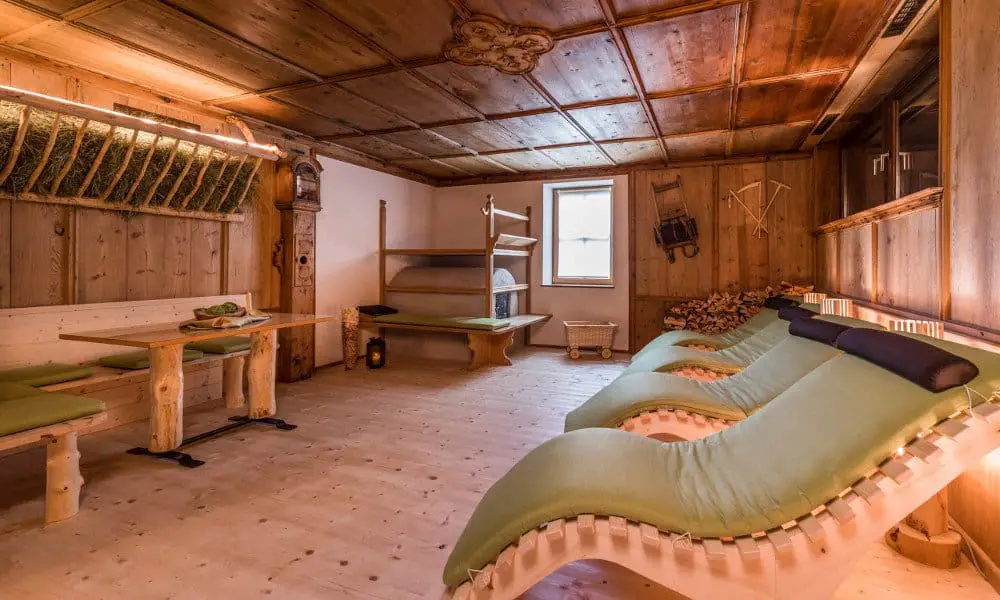
2. Controlled Lighting
In relation to color schemes, lighting is perhaps one of the most important but overlooked aspects of office space. Employees with 9-to-5 desk jobs rarely get natural light at the workplace . This is also another health risk
. This is also another health risk that workers face. Research shows that the average human needs to be exposed to the sun for at least a few minutes a day. Being stuck inside the four walls of the office means employees rarely get enough sunlight every day for it to be considered healthy.
that workers face. Research shows that the average human needs to be exposed to the sun for at least a few minutes a day. Being stuck inside the four walls of the office means employees rarely get enough sunlight every day for it to be considered healthy.
Considering the amount of natural light is an excellent initiative when planning your corporate wellness room. But make sure that the lighting could be adjusted. Ideally, a wellness room should receive a lot of natural light . But be mindful of employees who need to rest and take a quick nap as well. Installing thick, block-out curtains is a sure way to control the amount of light that enters the wellness room. If you’re looking into a more ambient relaxation room, you could opt to put warm, dimmable lamps inside.
. But be mindful of employees who need to rest and take a quick nap as well. Installing thick, block-out curtains is a sure way to control the amount of light that enters the wellness room. If you’re looking into a more ambient relaxation room, you could opt to put warm, dimmable lamps inside.
Installing indoor plants could also go a long way in improving the overall ambiance of a room. Plants are natural and well-rounded decorations to put up, and most indoor plants are relatively low maintenance. A little bit of nature never fails to create a relaxing vibe. Additionally, some green life inside the wellness room could improve the air quality inside, another tidbit that workers in need of a break will surely appreciate.
could also go a long way in improving the overall ambiance of a room. Plants are natural and well-rounded decorations to put up, and most indoor plants are relatively low maintenance. A little bit of nature never fails to create a relaxing vibe. Additionally, some green life inside the wellness room could improve the air quality inside, another tidbit that workers in need of a break will surely appreciate.
3. Cozy and Homey Furniture
Furniture in your wellness room must be as comfortable as possible. Keep in mind that your employees might have different problems, so do not limit yourself when deciding which pieces of furniture to install. Go for couches created using fabrics that are soft and plush, where some employees can breeze through a nap before getting back to work. Recliners and massagers are also useful additions, although not required.
In wellness rooms specifically targeted for relaxation, remember the tips we’ve discussed above regarding color. Try to match the vibe of the room’s interior with the furniture that you will place inside. If you want to achieve a warm and cozy relaxation room, a sofa or two in warm reds or browns will blend quite well in the room.
If you’re preparing a meditation room, it’s better to substitute the couches with plush rugs and thick mats instead. You can experiment with texture as well if you want a more dynamic experience for those seeking a few minutes of quiet mindfulness. Accessories like scented candles are also a nice touch when setting up the mood in your wellness room.
For people who are merely looking for a peaceful place to decompress or come up with new ideas, a co-working space is an excellent middle ground. A co-working space is a space away from the usual bustle of the office. At the same time, it’s also a place where employees can collaborate, brainstorm, and work on problems freely without the stiff formality of office etiquette.
In setting up a co-working space in the office, stick to furniture that is both fun and functional. Veer away from rigid-looking furniture and choose pieces with curved lines. Curved lines, as opposed to straight lines, encourage more communication and collaboration among employees. This is a useful tip to keep in mind not just when planning for your corporate wellness room but also other rooms and spaces in the office. (We have written a related article – How to Design a Feng Shui Office
in the office, stick to furniture that is both fun and functional. Veer away from rigid-looking furniture and choose pieces with curved lines. Curved lines, as opposed to straight lines, encourage more communication and collaboration among employees. This is a useful tip to keep in mind not just when planning for your corporate wellness room but also other rooms and spaces in the office. (We have written a related article – How to Design a Feng Shui Office )
)
4. Flooring and Wall Finish
When it comes to wall finish, do not be afraid of putting an accent wall that looks busier than the more neutral walls. Designing a relaxing room doesn’t have to be a dull and tedious affair. If you’re not too keen on doing that, a more minimalist approach is also an excellent option.
You can opt to put up some art on the walls, or if you’re feeling brave, you can experiment with texture and wall finishes . Remember that neutral colors are always the safest bet, and gray is an excellent middle ground between the starkness of black and white. The most important thing to remember is still your employees’ comfort and well-being. It’s also acceptable to work within a budget.
. Remember that neutral colors are always the safest bet, and gray is an excellent middle ground between the starkness of black and white. The most important thing to remember is still your employees’ comfort and well-being. It’s also acceptable to work within a budget.
Flooring is another design aspect to consider. Plush furniture goes well with laminated wood flooring. Wooden floors are also easy to clean, another advantage for wellness rooms that are communally used by your employees. Supplement your choice in flooring with elegant carpets. Again, depending on the color scheme you’re going for, you can choose from different types and colors of carpets.
In the case of fitness gyms and yoga rooms, a different kind of flooring is more appropriate. Typically, fitness gyms have interlocked rubber mats as flooring, which serve as a cushion during exercise. However, remember also that people will sweat a lot during exercise. Make sure that the flooring you install in your fitness room is easy to clean and disinfect. Take note that rubber wears out quickly, so be prepared to do maintenance and replace them as needed. Storage for things like towels and lockers will be an excellent addition if you have the budget and space.
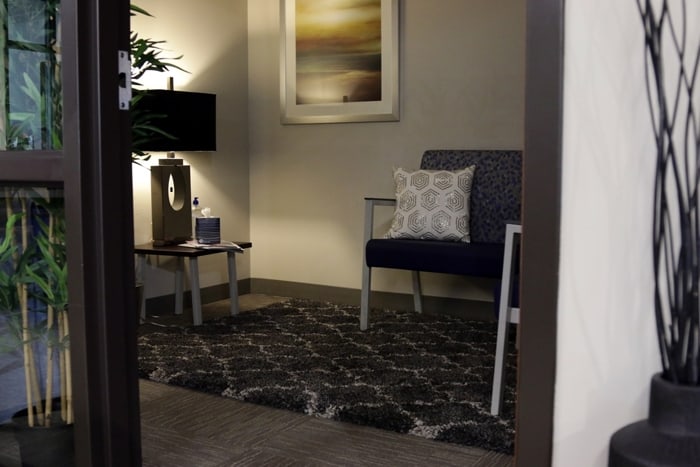
Wellness Rooms at the Workplace
We have written an extensive article, “What is a Wellness Room at Work? (Can They Boost Productivity) ” which provides a more detailed look at what a corporate wellness room is. As previously mentioned, a corporate wellness room is simply a space for employees to wind down and destress while at work. It is relatively private so an employee can relax for a while, then return to their work well-rested and refreshed.
” which provides a more detailed look at what a corporate wellness room is. As previously mentioned, a corporate wellness room is simply a space for employees to wind down and destress while at work. It is relatively private so an employee can relax for a while, then return to their work well-rested and refreshed.
There’s a saying that a happy wife means a happy life. It turns out that this also applies to employees. Workers need a wellness room for several reasons. Employee welfare is more than secure health benefits and an insurance plan. Employee wellness is composed of both physical and mental aspects—two factors that a corporate wellness room should be able to address.
Physical Wellness
Work environments, especially corporate set-ups, provide little opportunity for employees to be physically engaged. Although most corporate tasks are not physically-taxing, this is not always ideal. After all, the human body still needs an acceptable amount of physical activity to be healthy.
Most employees are seated all day; studies have shown that such practices cause some concerning health conditions in the corporate workplace. Staring at a computer screen for endless hours has adverse effects on health, particularly to the vision. In the office, prolonged exposure to electronic gadgets and UV rays is unavoidable.
A wellness room fitted with basic fitness equipment provides the opportunity for physical improvement. It could also offer workers a much-needed break from looking at computer screens in the office and technology in general.
Mental Wellness
The physical toll of work isn’t the only health-related concern for workers. Mental health awareness has become a forefront figure in the ever-changing workplace culture. Increasing demands at work have exacerbated the rise in mental health-related problems among workers. Thus, mental health has become a relevant concern in maintaining a humane and healthy work environment for your employees.
One of the best and easiest ways (not to mention cheapest) to address this concern is to set aside a quiet space for employees to retreat to as needed. When their stress levels at work have peaked, a calm space can go a long way in providing them an avenue to decompress before going back to work. They could also take short naps there and wake up refreshed and full of new ideas, maybe a more effective solution to a problem.

Wellness, Teamwork, and Office Dynamics
In the age of technology and social media, employees are now more aware of the detrimental effects of stress caused by workplace experience. Workers nowadays are smarter and more concerned with their health, and this translates to the environment that they expect at work. They are more likely to put their best foot forward, so to speak, when they know that they are valued and respected at work.
caused by workplace experience. Workers nowadays are smarter and more concerned with their health, and this translates to the environment that they expect at work. They are more likely to put their best foot forward, so to speak, when they know that they are valued and respected at work.
Aside from legal ramifications, your employees are still humans who feel emotions and get tired. Working nonstop used to be acceptable; now, there’s supporting knowledge which proves such practices cost a company more in the long run. We have written a detailed article, “What is Workplace Experience? (Workplace Experiences and Expectations) ” on our website, if you want to look into this further.
” on our website, if you want to look into this further.
Another vital issue that workplace wellness rooms address is teamwork. While it’s true that a wellness room is more intended to alleviate stress from individual employees, work facilities like this are also beneficial at the team-level. Each member is crucial to the team, which is why when one member is not functioning well, the entire team is affected. Addressing wellness problems that any team member could face prevents disruptions and inefficient work.
Furthermore, wellness rooms aren’t just designed to ensure physically and mentally healthy individuals. Social interaction is an essential aspect of human life. This applies particularly in the work environment as well, where people face problems and solve them daily. A wellness room could serve as an avenue where employees could socialize and engage with others in a less stressful situation.
is an essential aspect of human life. This applies particularly in the work environment as well, where people face problems and solve them daily. A wellness room could serve as an avenue where employees could socialize and engage with others in a less stressful situation.
When employees interact at wellness rooms, they could discuss projects and problems freely without the pressure of professional conduct getting in the way. Out-of-the-box ideas are more likely to come up in casual conversation than within the stifling four corners of the office.
There’s no need to fear that encouraging social interaction among coworkers will lead them to slack off. Researchers have already established that forming social ties in the workplace, among other things, are helpful in employee retention and absenteeism issues. And it makes sense because people are more likely to look forward to going to work if they have friends in the office.
and absenteeism issues. And it makes sense because people are more likely to look forward to going to work if they have friends in the office.
In addition to helping workplace dynamics, socializing with others is more likely to aid employees in generating creative ideas and new solutions. This idea is adapted from the concept of a “third place ” where people break away from the monotony of their daily routines to interact, decompress, and generate creative thoughts.
” where people break away from the monotony of their daily routines to interact, decompress, and generate creative thoughts.
The third place should be somewhere nearby, with a comfortable atmosphere. Theoretically, it’s not supposed to be at home or work—hence the name “third place”—but corporate wellness rooms function well as a substitute for coffee shops or libraries.
There are many advantages to a “third place” existing within the walls of the workplace. For one thing, it’s conveniently in the same location, so there’s no need to spend money on gas or fare. Another advantage is that resources like Internet connection, electricity, tables, and other essential office resources are readily available.
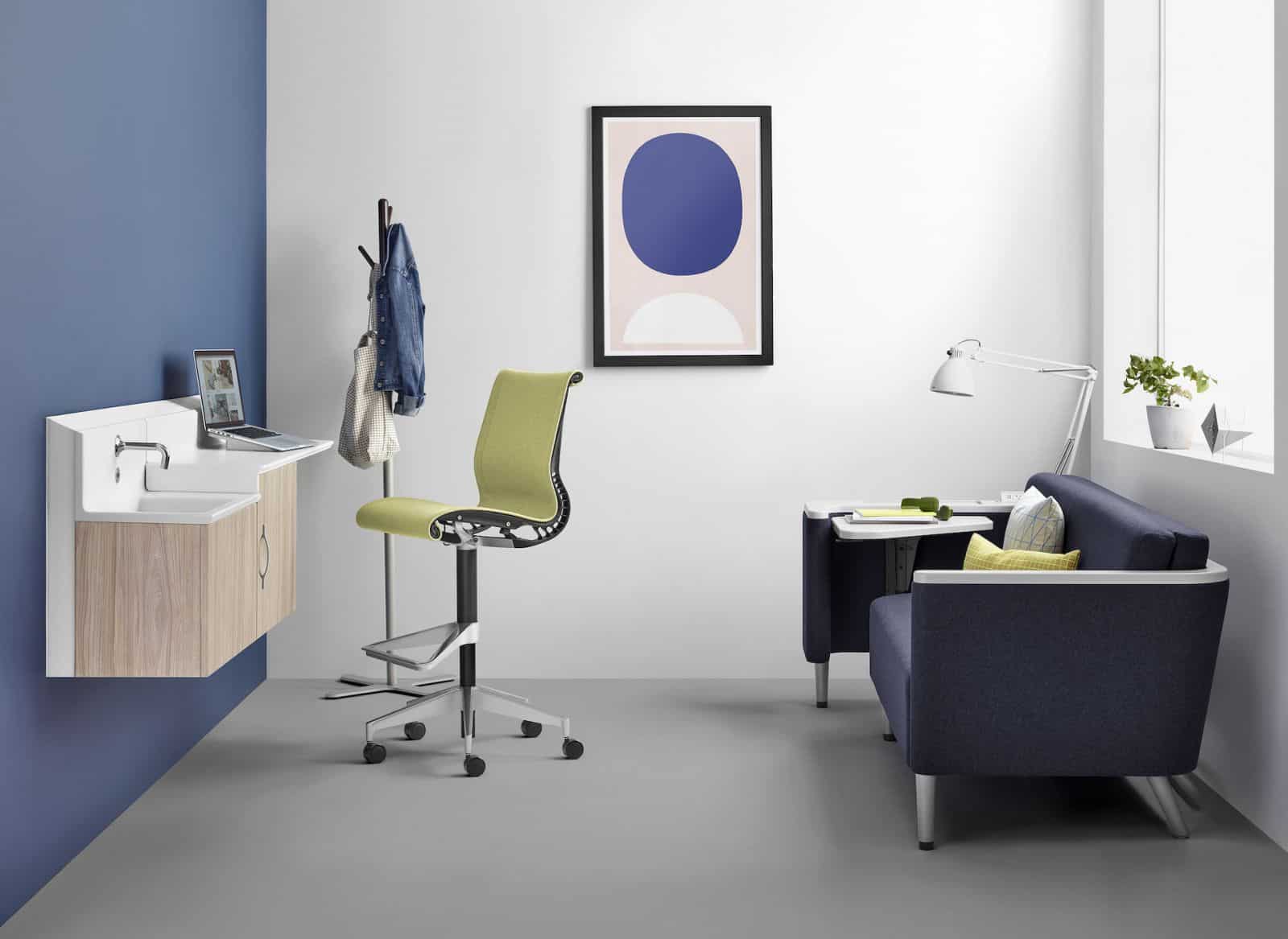
What Do Employees Do in Wellness Rooms?
After an extensive discussion on how to design a corporate wellness room and the importance of having one, you might ask yourself: What do employees even do in wellness rooms?
Employees have different types of needs and concerns. Some might be more affected mentally, and therefore in need of a mental break; others might be more concerned with their physical well-being. The first concern could be addressed with amenities like quiet spaces for thinking or meditation; the second one could be solved by putting up simple exercise equipment. However, a calm space for reflection and a fitness gym might not complement each other if placed in the same area.
This is the main reason why it’s crucial to determine your employees’ needs through direct and open communication. If you have no idea what your employees want or need to decompress at work, do not hesitate to ask them directly. If it’s logistically impossible, set up a suggestion box or disseminate an electronic survey. The important thing here is to send the message to your employees that you are listening to them, and you want them to have a pleasant and productive work environment.
Expressing a willingness to address employee needs sends a message that their boss cares about them. This, in turn, could potentially improve worker-employer relations , as well as lift the overall company morale.
, as well as lift the overall company morale.
Related Questions
Does a corporate wellness room cost a lot? It depends. We’ve listed various things that you could put or include in your corporate wellness room, but these are only guides for you. Your wellness room doesn’t need to be the grandest or the most elaborate. The most crucial step that you should do is to ask your employees what they need. After communicating with your team, you still need to parse through their answers and filter them according to importance and practicality, among other things. Stretching your company budget for a fully-equipped wellness room is unnecessary and a waste. Find the balance between providing what your workers need and spending reasonably. After all, a wellness room is not a substitute for your employee’s home where they could rest considerably or the clinic where they consult a doctor when they’re unwell.
Will adding a corporate wellness room reduce professionalism in the workplace? No. For employees, part of being professional is knowing their limits. Continuing to work despite fatigue or other problems is counterproductive. A worker running on less than optimal conditions will only hold back the workflow of an office, especially when working in a team setting.
Additionally, an employee in good health is an employee who’s in tiptop shape to act in his professional capacity. Concerns about professionalism are valid. But remember, the ideal wellness room is supposed to be private and secure. This is not just for the benefit of the employee’s well-being. A safe and private area means your employees can freely “turn off” their professional persona to recharge. Doing so will not compromise their workplace or even their coworkers’ focus.
Is it challenging to maintain a corporate wellness room? It depends on the type of wellness room, the number of users, as well as the activities that could be done there. If you’re concerned with additional costs in maintaining such areas, you can set up a system among your employees, which ensures that they manage the wellness room themselves. As its primary users, your employees have a vested interest in the maintenance of your wellness room. This is just one simple and cheap solution to maintenance concerns. At first, it would seem like the wellness room is not a worthy investment because there will be no visible monetary gains. But soon enough, you will notice the positive effects of having a corporate wellness room on your employees’ performance and outputs.

